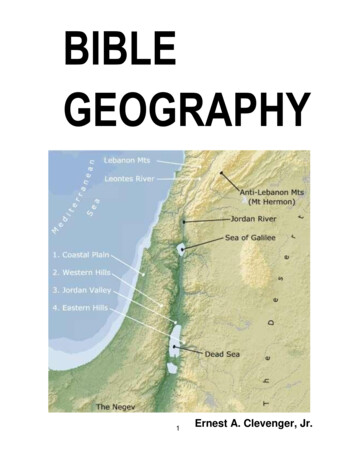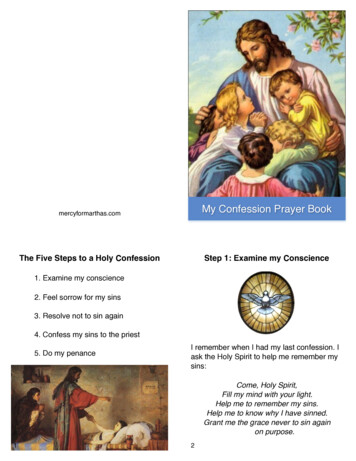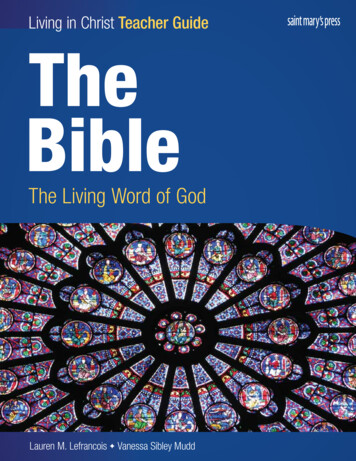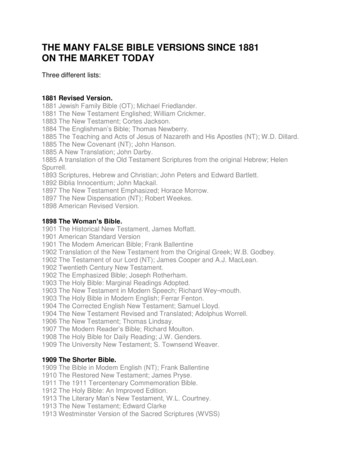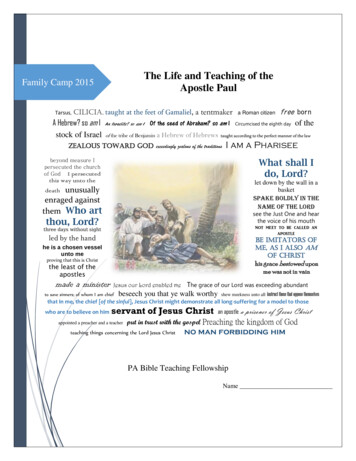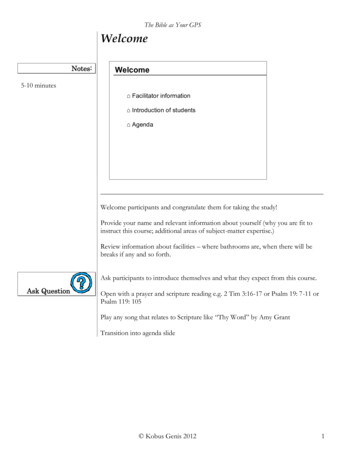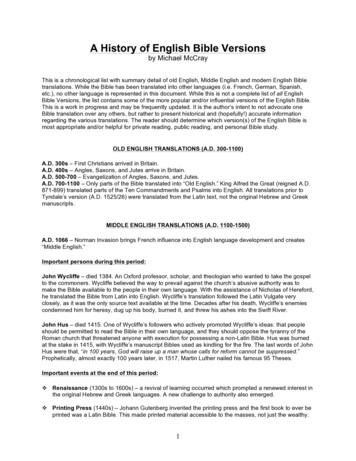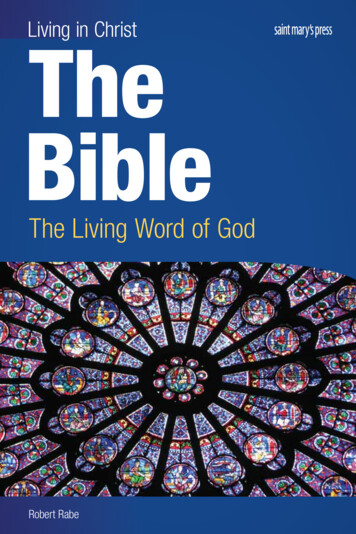
Transcription
Living in ChristTheBibleThe Living Word of GodRobert Rabe
Living in ChristTheBibleThe Living Word of GodRobert Rabe
The Subcommittee on the Catechism, United States Conference of CatholicBishops, has found that this catechetical high school text, copyright 2011, isin conformity with the Catechism of the Catholic Church and that it fulfillsthe requirements of Course I: “The Revelation of Jesus Christ in Scripture”of the Doctrinal Elements of a Curriculum Framework for the Development ofCatechetical Materials for Young People of High School Age.Nihil Obstat:Rev. William M. Becker, STDCensor LibrorumDecember 13, 2010Imprimatur:† Most Rev. John M. Quinn, DDBishop of WinonaDecember 13, 2010The nihil obstat and imprimatur are official declarations that a book or pamphlet is free of doctrinal or moral error. No implication is contained thereinthat those who have granted the nihil obstat or imprimatur agree with thecontents, opinions, or statements expressed, nor do they assume any legalresponsibility associated with publication.The publishing team included Gloria Shahin, editoral director; StevenMcGlaun, development editor; Brian Singer-Towns, consultant; Javier Bravo,contributing editor; Maura Thompson Hagarty, theological reviewer; Roxane Kadrlik Chlachula, contributing author; Chris Wardwell, contributingauthor; prepress and manufacturing coordinated by the production departments of Saint Mary’s Press.Cover Image: The Crosiers/Gene Plaisted, OSCCopyright 2011 by Saint Mary’s Press, Christian Brothers Publications,702 Terrace Heights, Winona, MN 55987-1320, www.smp.org. All rightsreserved. No part of this book may be reproduced by any means without thewritten permission of the publisher.Printed in the United States of America1144 (PO4169)ISBN 978-1-59982-080-4, Saint Mary’s Press Online Learning Environment
ContentsIntroduction . . . . . . . . . . . . . . . . . . . . . . . . . . . . . . . . . . . . . . . . . . 7Section 1: RevelationPart 1: The Desire to Know God. . . . . . . . . . . . . . . . . . 10Article 1: Longing for God . . . . . . . . . . . . . . . . . . . . . . . . . . . 11Article 2: God’s Invitation . . . . . . . . . . . . . . . . . . . . . . . . . . . . 13Article 3: Happiness in God Alone . . . . . . . . . . . . . . . . . . . . . 15Article 4: Saint Augustine and the Four Objects of Love . . . 17Part 2: Natural Revelation . . . . . . . . . . . . . . . . . . . . . . . 21Article 5: The Sacred Scriptures and Natural Revelation . . . 22Article 6: Natural Revelation and the Wisdom of the ChurchFathers . . . . . . . . . . . . . . . . . . . . . . . . . . . . . . . . . . 24Article 7: Natural Revelation and Scholastic Theology . . . . . 27Article 8: Natural Revelation: Vatican Council I to the Present29Part 3: Divine Revelation . . . . . . . . . . . . . . . . . . . . . . . . 33Article 9: Salvation History: God’s Revelation . . . . . . . . . . . . 34Article 10: Salvation History in the Old Testament . . . . . . . . 36Article11: Jesus Christ: The Fullness of All Revelation . . . . . 39Article 12: The Transmission of Divine Revelation . . . . . . . . . 41Article 13: Sacred Scripture and Sacred Tradition . . . . . . . . 45Section 2:Interpretation and Overview of the BiblePart 1: Understanding the Scriptures . . . . . . . . . . . . . 49Article 14: Divine Inspiration and Biblical Inerrancy . . . . . . . 50Article 15: From the Spoken to the Written Word . . . . . . . . . 51Article 16: When Was It Written? . . . . . . . . . . . . . . . . . . . . . . 54Article 17: Setting the Canon of Scripture . . . . . . . . . . . . . . . 56Article 18: Different Translations: The Same Revelation . . . . 58
Part 2: Interpreting Scripture . . . . . . . . . . . . . . . . . . . . 61Article 19: A Vocation to Interpret and Teach . . . . . . . . . . . . 62Article 20: Biblical Exegesis . . . . . . . . . . . . . . . . . . . . . . . . . . 64Article 21: Literary Forms in the Bible . . . . . . . . . . . . . . . . . . 66Article 22: Senses of the Scriptures . . . . . . . . . . . . . . . . . . . 68Article 23: Relation to Science and History . . . . . . . . . . . . . . 70Article 24: Other Avenues to Understanding the Scriptures . 72Part 3: Overview of the Old and New Testaments . . . 76Article 25: The Old Testament: Old Does Not Mean“Out of Date” . . . . . . . . . . . . . . . . . . . . . . . . . . . . . 77Article 26: The Old Testament: General Overview . . . . . . . . . 78Article 27: The Canon of the Old Testament . . . . . . . . . . . . . 81Article 28: The New Testament: Why Is It Called “New”? . . . 82Article 29: The New Testament: General Overview . . . . . . . . 84Article 30: The Canon of the New Testament . . . . . . . . . . . . 87Section 3: Revelation in the Old TestamentPart 1: The Book of Genesis . . . . . . . . . . . . . . . . . . . . . 90Article 31: Creation: In the Beginning . . . . . . . . . . . . . . . . . . 91Article 32: Sin and God’s Response . . . . . . . . . . . . . . . . . . . 94Article 33: Abraham . . . . . . . . . . . . . . . . . . . . . . . . . . . . . . . . 97Article 34: Isaac, Jacob, and Joseph . . . . . . . . . . . . . . . . . 100Part 2: The Book of Exodus . . . . . . . . . . . . . . . . . . . . 104Article 35: A People Enslaved . . . . . . . . . . . . . . . . . . . . . . . 105Article 36: The Exodus . . . . . . . . . . . . . . . . . . . . . . . . . . . . . 107Article 37: Building Trust in God . . . . . . . . . . . . . . . . . . . . . 110Article 38: The Ten Commandments . . . . . . . . . . . . . . . . . . 111Part 3: The Historical Books . . . . . . . . . . . . . . . . . . . . 115Article 39: Joshua: God Is on Our Side . . . . . . . . . . . . . . . . 116Article 40: Judges: The Book of Deliverers . . . . . . . . . . . . . 119Article 41: From Saul to Solomon: The Desire for Unity . . . 122Article 42: David: Recognizing a Servant . . . . . . . . . . . . . . 124
Part 4: The Prophetic Books . . . . . . . . . . . . . . . . . . . 128Article 43: The Prophets: A Radical Redemption . . . . . . . . 129Article 44: Major and Minor Prophets . . . . . . . . . . . . . . . . . 132Article 45: Ezekiel: Challenging Idolatry and Injustice . . . . . 132Article 46: Jeremiah: Success in the Lord . . . . . . . . . . . . . . 135Article 47: Isaiah: The Long-Awaited One . . . . . . . . . . . . . . 137Part 5: Wisdom Literature . . . . . . . . . . . . . . . . . . . . . . 141Article 48: Job: Understanding Suffering. . . . . . . . . . . . . . . 142Article 49: The Psalms: Learning to Pray. . . . . . . . . . . . . . . 145Article 50: Ecclesiastes: The Ongoing Search for Meaning 147Article 51: Song of Songs: The Beauty of Love. . . . . . . . . . 149Article 52: Wisdom: Seeking Truth. . . . . . . . . . . . . . . . . . . . 151Section 4: Revelation in the New TestamentPart 1: The Gospels . . . . . . . . . . . . . . . . . . . . . . . . . . . 156Article 53: The Central Place of the Gospels. . . . . . . . . . . . 157Article 54: Three Stages in Gospel Formation . . . . . . . . . . . 160Article 55: Why Four Gospels? . . . . . . . . . . . . . . . . . . . . . . 161Part 2: Revelation in and through Jesus in theSynoptic Gospels. . . . . . . . . . . . . . . . . . . . . . . . . . . . . 165Article 56: The Gospel of Matthew . . . . . . . . . . . . . . . . . . . 166Article 57: The Gospel of Mark . . . . . . . . . . . . . . . . . . . . . . 168Article 58: The Gospel of Luke. . . . . . . . . . . . . . . . . . . . . . . 171Article 59: The Central Accounts in the Synoptic Gospels . 173Article 60: The Parables and Miracles in the SynopticGospels . . . . . . . . . . . . . . . . . . . . . . . . . . . . . . . . 177Article 61: The Paschal Mystery in the Synoptic Gospels . 179Part 3: Revelation in and through Jesusin the Gospel of John . . . . . . . . . . . . . . . . . . . . . . . . . 184Article 62: The Gospel of John: God Incarnate . . . . . . . . . . 185Article 63: Signs and Miracles . . . . . . . . . . . . . . . . . . . . . . . 187
Article 64: The “I Am” Statements . . . . . . . . . . . . . . . . . . . . 189Article 65: The Bread of Life and Last Supper Discourses . 190Article 66: The Passion, Death, and Resurrection . . . . . . . . 193Part 4: Acts and Letters . . . . . . . . . . . . . . . . . . . . . . . 196Article 67: The Acts of the Apostles . . . . . . . . . . . . . . . . . . 197Article 68: The Pauline Letters . . . . . . . . . . . . . . . . . . . . . . . 199Article 69: The Catholic Letters . . . . . . . . . . . . . . . . . . . . . . 202Article 70: The Book of Revelation . . . . . . . . . . . . . . . . . . . 205Section 5:The Scriptures and the Life of FaithPart 1: The Scriptures and the Life of the Church . . 210Article 71: The Study of the Sacred Scriptures . . . . . . . . . . 211Article 72: The Centrality of the Scriptures in the Massand Other Liturgies . . . . . . . . . . . . . . . . . . . . . . . 212Article 73: The Liturgy of the Hours: A Window into the DailyRhythms of Life . . . . . . . . . . . . . . . . . . . . . . . . . . 215Article 74: The Lord’s Prayer: Rooted in the Scriptures . . . 218Article 75: The Scriptures and the Rules of the Saints . . . . 221Part 2: The Scriptures and the Life of the Individual 224Article 76: Lectio Divina . . . . . . . . . . . . . . . . . . . . . . . . . . . . 225Article 77: The Scriptures and Morality . . . . . . . . . . . . . . . . 228Article 78: Individual and Communal Prayer with theScriptures . . . . . . . . . . . . . . . . . . . . . . . . . . . . . . 229Article 79: Two Devotional Prayers and Their ScripturalConnections . . . . . . . . . . . . . . . . . . . . . . . . . . . . 231Glossary . . . . . . . . . . . . . . . . . . . . . . . . . . . . . . . . . . . . . . . . . . 236Index . . . . . . . . . . . . . . . . . . . . . . . . . . . . . . . . . . . . . . . . . . . . . 247Acknowledgments . . . . . . . . . . . . . . . . . . . . . . . . . . . . . . . . . . 260
Introduction“In the beginning . . .” (Genesis 1:1)These are the first words in the Bible, and it is fitting that they shouldbe the first words in this book. The beginning point for any exploration of our faith is discovering that God has revealed himself to us. Thiscourse starts by exploring God’s Revelation, which is communicated to usthrough Tradition and Scripture. The course will focus on Sacred Scripture, the Bible. As the editor for this book I am excited to welcome you towhat can be an amazing encounter with the living Word of God.I imagine that in your home there is at least one Bible. In my homethere are three. Two of them belonged to my grandparents. Those Biblessit in a prominent space on a shelf in my home office. When my grandparents passed away, I asked for their Bibles because, for me, they are a specialconnection to a part of my past. They remind me of my family and myhistory. They remind me of the love my grandparents had for each otherand passed on to my parents and to me. When I first acquired these BiblesI sat down and leafed through their pages. I found passages that had beenmarked as important by my grandparents. I discovered old family picturesof my parents and relatives I did not know. I came across documents thatwere tucked into the Bibles for safe keeping. I do not open these Biblesmuch anymore because I want them to stay intact. However, I am veryaware of these treasured possessions, and deeply grateful for them.The third Bible in my office is the one I use personally and for mywork. I consult this Bible often. I have important passages marked. I havenotes tucked into it. The pages are getting tattered from use. This Bibleplays a part in my spiritual and professional life almost every day, alwaysbringing me closer to God.These three Bibles—the ones reverently placed on a shelf and rarelytouched anymore and the one pulled off the shelf and consulted daily—are a good example of what Scripture is in my life. It is a connection tomy personal history and the history of the faith I hold so dear. It helps meknow where I come from, what I was created for, and of God’s enduringgoodness in reaching out to me and to all his people to lead us to salvation.My hope is that Scripture can do the same for you—that it will connectyour life today to the history of our salvation and to the promise of eternallife, and that it will help you grow in your relationship with God, and guideyou in how to live your life and bring the Good News of Jesus Christ toothers.7
8IntroductionYou are going to learn a great deal about God and Scripture during this course, with this book as the starting point. But this book, and asingle semester, cannot teach you everything there is to know about God’sRevelation. Seeking this understanding is a life-long journey. I constantlydiscover new insights in my well-worn Bible. My hope is that through thiscourse and lifelong study of Scripture, you too will continually encounterthe living Word of God.Peace and Blessings,Steven McGlaun, editor
Section 1Revelation
Part 1The Desireto Know Gode are created with a longing, a yearning, for God.Each of us yearns for a life of meaning and truth,which can find fulfillment only in our supreme, good, andloving God. God desires that we know him. It is easy tobecome distracted by worldly promises and definitionsof happiness, goodness, and beauty, but God continuallyinvites and challenges us to renounce the distortions ofthis world and fix our eyes on the infinite truth found in himalone. There is only one answer, one choice, if we wantto be truly happy in this life and the next. That answer isGod—our God who knew us before we were born, knowsour thoughts before we speak them, and leads us on thepath to salvation.The topics covered in this part are:W Article 1: “Longing for God” (page 11) Article 2: “God’s Invitation” (page 13) Article 3: “Happiness in God Alone” (page 15) Article 4: “Saint Augustine and the Four Objects of Love”(page 17)10
Part 1: The Desire to Know GodeticlAr1Longingfor GodHunger . . . thirst . . . yearn . . . crave . . . long . . .need! When we use these words, we speak of the desire tofill an emptiness, a void, in our lives. We all have the needto satisfy this inner longing. Because this inner longing is“written in the human heart” (Catechism of the CatholicChurch [CCC], 27) by God, people experience a restlessness that only God can satisfy. To be human is to embarkon a journey of wandering, as the Israelites did during theExodus, knowing that the one true direction and destinationis God alone.Humanity as Religious BeingsEach one of us is a religious being. Whether we realize itor not, our vocation (from the Latin, meaning “to call”) asreligious beings is to live fully human lives—lives in whichwe know, love, and freely choose God. When we call humansreligious beings, we are saying they are made by and forGod, “to live in communion with God” (CCC, 45). Withinthe human heart is a place—a God-shaped hole—desiringto be filled with God’s infinite love. From the moment ofconception, we were knitted in our “mother’s womb” (Psalm139:13) with a desire for truth and happiness that only God11desireFrom the Latin desidero, “to long for whatis absent or lost.”vocationA call from God toall members of theChurch to embrace alife of holiness. Specifically, it refers to a callto live the holy life asan ordained minister,as a vowed religious(sister or brother), in aChristian Marriage, orin single life.Pray It!Holy Desire for GodHave you ever felt a desire for silence and prayer? God’s love draws us to himand calls us to respond to him with love. Sometimes we experience his love as ayearning in our heart. Saint Teresa of Ávila, the first woman Doctor of the Church,wrote about how God reaches out to us every day. The next time you are in prayer,reflect on the following words of Saint Teresa:This Lord of ours is so anxious that we should desire him and strive after his companionship that he calls us ceaselessly, time after time, to approach him; and thisvoice of his is so sweet. . . . His appeals come through the conversations of goodpeople, or from sermons, or through the reading of good books . . . through sicknesses and trials, or by the means of truths which God teaches us at times when weare engaged in prayer; however feeble such prayers may be, God values them highly.
12Section 1: Revelationcan satisfy. We find expressions of this desire in both theSacred Scriptures and in the lives of the saints.The Book of Psalms, in the Old Testament, illuminatesthat we are religious beings with longings that can findmeaning and rest only in the knowledge and wisdom ofGod. Psalm 42 speaks of the quest for God in this way: “Asthe deer longs for streams of water, / so my soul longs foryou, O God. / My being thirsts for God, the living God”(verses 2–3). The psalmist, writer, and composer comparesthirst for God to a deer that is parched, longing for refresh-Saint John of the Cross and Saint Teresa of ÁvilaBoth Saint John of the Cross and SaintTeresa of Ávila were sixteenth-century mystics who sought to reform the Carmelitereligious order. Their goal was to establisha deeper life of prayer and austerity forthe order’s members. The reform eventuallyled to the establishment of the Discalced(“without shoes”) Carmelites. The twosaints are considered Doctors of theChurch,Icons of Saint John of the Cross and Saint Teresa of Avila painted by Lynne Taggartalong with thirty-one other saintsand holy people, because of theirabundant writings on doctrine andthe spiritual life. John is knownfor his writings Ascent of MountCarmel, The Dark Night, and The Living Flame of Love. Teresa is mostnotable for authoring The Way ofPerfection and The Interior Castle.
Part 1: The Desire to Know Goding and plentiful water. In Psalm 23 we find a people desiring a shepherd who gives strength, provides protection, andsets a banquet of love.The lives of the saints illustrate humanity’s “quest forGod” (CCC, 28), a people moving toward God at all times tofind completion. Saint John of the Cross (1542–1591) wrote:“One dark night, fired with love’s urgent longings. . . . Onight that has united the Lover with his beloved” (The Collected Works of Saint John of the Cross, pages 358–359). Inthis poetic line, John speaks of his soul’s burning desire to beunited with God, the Lover. Saint Teresa of Ávila (1515–1582)states, “In the measure you desire Him, you will find Him.”According to both saints, persistent longing and authenticdesire are the direct paths to God.Going Toward GodIn the words of Saint Augustine of Hippo (354–430), “Thewhole life of a good Christian is a holy desire to see God asHe is.” Because we came from God and are going towardhim, our ultimate desire is union with him. As religiousbeings, our whole spiritual journey is characterized by anunceasing craving to know the saving hand of God. Whenwe respond to the invitation to live in communion with God,we become more fully the people he created us to be. eticlAr2God’sInvitationWe spend much of our time on earthbuilding relationships. Science, psychology, and our experiences tell ushealthy relationships are necessaryfor us to survive and thrive. The heartof any healthy relationship is a strong,intimate bond, closeness, or union, challenging us to become people of compassionand faith. The most important relationship we have is with God. Sacred Scripturereminds us of the critical importance ofknowing God and his mighty power to saveus (see Philippians 3:8–11). S.Rimkuss / shutterstock.com13
14Section 1: RevelationIncarnationFrom the Latin, meaning “to become flesh,”referring to the mystery of Jesus Christ,the divine Son of God,becoming man. In theIncarnation, JesusChrist became trulyman while remainingtruly God.salvationFrom the Latinsalvare, meaning“to save,” referringto the forgiveness ofsins and assurance ofpermanent union withGod, attained for usthrough the PaschalMystery—Christ’swork of redemptionaccomplished throughhis Passion, death,Resurrection, andAscension. Only at thetime of judgment cana person be certain ofsalvation, which is agift of God.God constantly calls us to relationship with him. Pastoral Constitution on the Church in the Modern World (Gaudium et Spes, 1965) states that “from the very circumstance ofhis origin man is already invited to converse with God” (19).In other words we are invited into communion with Godand to experience the grace of his saving love. God wants toknow, love, and hold us. Therefore, he “never ceases to drawman to himself ” (CCC, 27).Jesus Christ: God’s Greatest InvitationBecause God so longs for a relationship with us, he reachedout in a radical way. In the Incarnation the Word of Godbecame flesh in the person of Jesus Christ. Through JesusChrist, “God has revealed himself and given himself ” (CCC,68) to human beings in a new way so we may heed andunderstand the message of salvation. In fact, the meaning ofthe name Jesus is “God saves.” In and through Jesus Christ,God has “provided the definitive, superabundant answer tothe questions that man asks himself about the meaning andpurpose of his life” (68). The Incarnation of the Son of Godis about God’s love for humanity. Because of his love for us,God sent his only Son, who is God himself, to invite us intoa life-giving relationship with him. God’s dwelling among usis a further extension of his invitation to communion andeternal salvation. Although we build many relationshipsthroughout life, no relationship is greater than the one wehave with our God. Catholic WisdomFacts about Pope John XXIIIDid you know that Pope John XXIII’s name was Angelo Giuseppe Roncalli? Roncallicame from a family of sharecroppers and knew the value of hard work. In 1915he was drafted to serve his country as a sergeant in the medical corps as a priest.The guidance of the Holy Spirit, his deep spirituality, and his ministry in the Churchgave him an understanding of the importance of renewal in the Church.
Part 1: The Desire to Know God15Gaudium et SpeseticlAr3Happinessin God Alone“What do I need to be truly happy in this lifetime?” Allpeople encounter this question at some point. Most of usstruggle with it throughout our entire lives. In our culturethe media offer various answers to this question. They rangefrom expensive homes, cars, and clothing to lives of promiscuous sex and experimentation with drugs and alcohol. Even Franklin McMahon/CORBISIn 1962 Pope John XXIII opened the Second Ecumenical Council of theVatican. This Council became known as Vatican Council II. This Council, likeall Ecumenical Councils, was a gathering of the Church’s bishops from allaround the world, convened by the Pope. Pope John XXIII wanted the Church torespond in a relevant manner to the cares and concerns of people in a rapidlychanging world. Vatican II ended in 1965. Among the many documents written at Vatican II was Gaudium et Spes. This document is also known as PastoralConstitution on the Church in the Modern World. It had the goal of “scrutinizing the signs of the times” and “interpreting them in the lightof the Gospel” (4). Among the many issuesaddressed were the dignity of the humanperson, the necessity of communityin an individualistic world, andhuman beings’ relationshipto the universe. Italso dealt withthe Church’srole in theformation ofpeople, thesanctity ofmarriage andfamily life,and economicand socialjustice.
16Section 1: Revelationthough people buy into these cultural approaches to happiness, they are still unhappy. Why?The promises of this world are empty, lacking depthand meaning. Therefore they often provide momentarysatisfaction or relief but eventually leave us looking for a fixto our unhappy and aching spirits. We may try to fill thevoid of unhappiness with the greatest and latest cell phone,computer, fashion trend, and so on. Through advertising,the media have been able to convince people that materialgoods answer our dissatisfactions with life. All these things,though good in moderation, will still leave us looking fortrue happiness.According to Saint Augustine, we need not look anywhere for happiness but to God, “for our hearts are restlessuntil they rest” in him. Happiness and truth can be foundonly when we live “in communion with God” (CCC, 45).The BeatitudesBlessed are the poor in spirit,for theirs is the kingdom of heaven.Blessed are they who mourn,for they will be comforted.Blessed are the meek,for they will inherit the land.Blessed are they who hunger and thirst for righteousness,for they will be satisfied.Blessed are the merciful,for they will be shown mercy.Blessed are the clean of heart,for they will see God.Blessed are the peacemakers,for they will be called children of God.Blessed are they who are persecuted for the sake of righteousness,for theirs is the kingdom of heaven.Blessed are you when they insult you and persecute you and utter everykind of evil against you [falsely] because of me. Rejoice and be glad, for yourreward will be great in heaven.(Matthew 5:3–12)
Part 1: The Desire to Know GodGod always takes the first step in calling us to live in communion with him. Responding to God’s call means weremove the promises and distractions of this world andfocus on him in order to have a clearer sense of his visionand path.God is “our first origin and our ultimate goal” (CCC,229). He is our beginning and our destiny. Thus happinessis found only in a life fully committed to him. Being fullycommited to God means putting our faith in him. The HolySpirit works in us and helps us to believe by preparing usto receive the gift of faith. This is God’s supernatural gift offaith, which leads us to choose God with our whole heartsand minds, so we neither prefer “anything to him” nor “substitute anything for him” (229). When we make this choice,we will want to live a life based on the Beatitudes—recognizing that true happiness is found in God alone. Jesus Christ,God’s infinite Word and Wisdom, gave us the Beatitudes as akey for living in true happiness. eticlAr4Saint Augustine andthe Four Objects of LoveHave you ever noticed that some people get along witheveryone? It seems that the more friends they have, the morefriends they make. This is possible because within our heartand soul is a tremendous capacity to love. The more we love,the more love we have to give—within limits, of course.Love, sometimes referred to as caritas, from a Latin termmeaning “charity,” is equated with the emotions of affection,reverence, and blessing. Love describes the manifestation ofGod’s presence in creation. As Christians our primary callis to give and accept love. Underlying much of the Christian understanding of love are the words and wisdom ofSaint Augustine of Hippo, an early Father and Doctor ofthe Church, who proclaimed that there are four objects weshould love: God, our neighbors, ourselves, and our bodies.God“You shall love the Lord, your God, with all your heart, withall your soul, and with all your mind” (Matthew 22:37).Jesus Christ himself says this is the Greatest Commandment.17
18Section 1: Revelation“The way ofsalvation iseasy; it isenough tolove.”(Margaretof Cortona,1247–1297)Before we can love anything or anyone, we must first loveGod, who breathed life into our bodies. But love does notstart with us. We are only able to love because God lovedus first. Once we respond to him and give ourselves fully tohim, the love that flowed from the wounds of Jesus Christ onthe cross will inflame our hearts with a fire that cannot beextinguished.NeighborsAccording to Augustine, if we do not love our neighbors, wedo not love God. Loving our neighbors does not mean wealways agree with their attitudes and actions. It means werevere and respect them because God has created every person “in his image” (Genesis 1:27). After all, Jesus did exclaimthat the second Greatest Commandment is: “You shall loveyour neighbor as yourself ” (Matthew 22:39). Summerfield Press/CORBISSaint Augustine taughtthat our love shouldfocus on God, our neighbors, ourselves, and ourbodies. Which of thesefour is easiest for you tolove? Which is hardest?
Part 1: The Desire to Know God19SelvesTo love ourselves is to love God. Self-love is the realizationthat God is imprinted on our heart, waiting, wanting to bedisplayed to the world in a beautiful and magnificent way.Knowing that Jesus Christ gave himself for our salvationpoints to our infinite worth and value—God himself died forus. Love of self must not become selfish or contrary to God’swill but should empower us to move beyond ourselves andbuild the Reign of God, where everyone can see their ownvalue.“At the endof life, we willbe judged bylove.”(Saint John of theCross, 1542–1591)BodiesAugustine said, “When God created the body, He showed agreater regard for beauty than for necessity.” In other words,our bodies are one of God’s great artistic masterpieces.These bodies, which will be resurrected someday, manifestGod’s greatness, goodness, and glory. Because of this reality,we must hold our bodies in high esteem. The body bearsGod’s creative hand. Therefore “it is animated by a spiritualsoul, and it is the whole human person that is intended tobecome, in the body of Christ, a temple of the Holy Spirit”1(CCC, 364). Live It!Loving by ListeningOne way you can love is by listening well. Listening is more than just physicalhearing. Good listening is a gift that takes time and energy. It demands your fullpresence and attentiveness. It is sometimes difficult to listen, especially when theperson speaking is in pain.Listening also fits in with Saint Augustine’s four objects of love. Listening toGod in prayer and in his Word is essential in the life of a Christian. Listening to yourneighbor is love too. If anyone has ever attentively listened to your problems, youknow what a wonderful gift it is to be able to get things off your chest. Listening toyourself—your own fears, needs, hopes, and dreams—is important in discerningyour vocation in life. Athletes will attest to the importance of listening to our bodies, which speak to us in many ways. Take time to listen well. It’s
ture, the Bible. As the editor for this book I am excited to welcome you to what can be an amazing encounter with the living Word of God. I imagine that in your home there is at least one Bible. In my home there are three. Two of them belonged to my grandparents. Those Bibles sit in a promin


